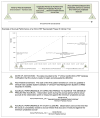Predicting accrual achievement: monitoring accrual milestones of NCI-CTEP-sponsored clinical trials
- PMID: 21447723
- PMCID: PMC3074352
- DOI: 10.1158/1078-0432.CCR-10-1730
Predicting accrual achievement: monitoring accrual milestones of NCI-CTEP-sponsored clinical trials
Abstract
Purpose: The need to increase the number oncology clinical trials with sufficient enrollments is a well-known issue, particularly for trials targeting therapeutic applications. It is critical to identify early predictors of eventual study accrual achievement.
Experimental design: All nonpediatric phase I, I/II, II, and III therapeutic studies supported by the National Cancer Institute Cancer Therapy Evaluation Program (NCI-CTEP) between 2000 and 2007 (n = 764) were analyzed for accrual performance. Accrual achievement is defined as those enrolling 100% or more of the stated minimum accrual goal at the time of trial closure. Two accrual milestones were analyzed per trial: time to first patient enrollment and expected time to accrual goal. Multivariate logistic regression analysis was used to calculate the OR with respect to the likelihood of clinical trial accrual achievement.
Results: A total of 81.5% (n = 623) of the trials did not achieve the projected accrual goals within the anticipated accruing period. Furthermore, 37.2% (n = 284) of trials failed to achieve the minimum projected accrual at study closure regardless of time the trial was open. Trials that accrue the first enrollment beyond 2 months (n = 379, 49.6%) are significantly less likely to achieve the accrual performance than those trials that enroll patients under 2 months (OR: 0.637, 95% CI: 0.464-0.875, P = 0.005). Of the studies that are open beyond the anticipated enrollment period (n = 603), those do not achieve at least 60.0% of the projected minimum accrual (n = 391, 64.8%) have a significantly less likelihood of achieving final accruals by study closure (OR: 0.190, 95% CI: 0.055-0.652, P = 0.008).
Conclusions: The time to first patient enrollment and expected time to accrual goal are shown to be valid measures to evaluate the likelihood of achieving the minimum projected accrual.
Conflict of interest statement
The authors indicate no potential conflicts of interest
Figures


References
-
- Surveillance Epidemiology and End Results. Retrieved August 30, 2008, 2008, from http://seer.cancer.gov/
-
- Abrams JS, Murgo A, et al. NCI’s cancer therapy evaluation program: a commitment to treatment trials. Cancer Treat Res. 2007;132:31–50. - PubMed
-
- Ansher SS, Scharf R. The Cancer Therapy Evaluation Program (CTEP) at the National Cancer Institute: industry collaborations in new agent development. Ann N Y Acad Sci. 2001;949:333–40. - PubMed
Publication types
MeSH terms
Grants and funding
LinkOut - more resources
Full Text Sources
Medical

